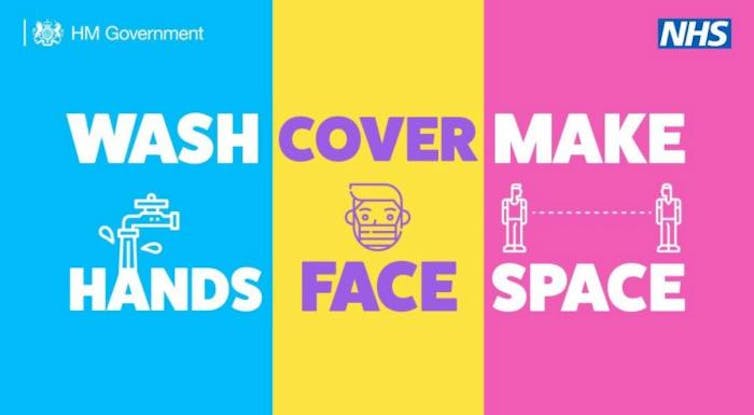Nathan Abrams, Bangor University; Anaïs Augé, Bangor University; Maciej Nowakowski, Bangor University, and Thora Tenbrink, Bangor University
Across western countries, people are polarised over wearing masks. While some support wearing them as an effective counter to the virus, others believe having to mask up is a contravention of their human rights.
Our interdisciplinary team is currently exploring the role the media plays in influencing the British public’s thoughts and decisions on mask wearing. We’ve found that these polarised opinions have been reflected and reinforced by the media, where a clear divide has appeared.
Pro-mask messages are more present in mainstream media, including in public health adverts and on TV. Conversely, anti-mask wearing sentiments are more common in personalised sources like social media.
Here, mask wearing is often associated with the historical commands of authoritarian governments. Some have even compared mask mandates to the Nazi policy of forcing Jews to wear distinguishing yellow stars.
This split in attitudes is a relatively new development. People were more cooperative when asked to wear masks in response to earlier health epidemics and other dangers in the 20th century.
Indeed, a 2021 study outlines how approval rates for face coverings during earlier crises were far more collectively positive. During influenza in 1918, the Blitz in Britain in 1941, and the smog outbreaks that occurred in the UK from the 1930s to the 1960s, masks weren’t contested like today. What explains this change?
The tangibility of past crises
The coronavirus is invisible to the human eye, and its worst effects aren’t seen publicly – they occur at home or in hospital wards away from people’s gaze.
Smog, on the other hand, could be seen. Similarly, the threat of a Nazi attack in the 1940s was manifested in smoke, debris and dust in the air after German bombing, as well as physical destruction and rubble. Even influenza in 1918, despite its symptoms being very similar to COVID’s, had arguably more publicly visual characteristics (such as vomiting and diarrhoea) that allowed it to resist public scepticism.
It may be that the actual visibility of these earlier crises made them seem more threatening, and so wearing a mask seem more necessary. Indeed, in a bid to make the dangers posed by COVID appear more tangible, politicians and the media have invoked the language of war when discussing COVID, or used images of people on ventilators to materialise the threat.
But such tactics have yielded significant debates among health professionals and linguists, as these produce questionable implications, such as potentially identifying infected people as “enemies” who bear and spread the virus.
Variety of the media
A second factor is that formerly, media was restricted to channels controlled or influenced by government, and these all gave positive depictions of masks. Today, however, there are many other channels, which allow for resistance.
During earlier crises, the media promoted mask wearing as a patriotic act. However, the media’s scope in the first half of the 20th century was far more limited than it is today. Promotion of mask wearing was mainly limited to government-approved posters and newsprint in the 1910s.
Mainstream radio didn’t exist until a decade later. And TV was only introduced in the 1930s but wasn’t widespread until much later. Radio, print and newsreels were the main sources of public information during past eras of mask wearing.
By contrast, today’s media landscape – especially social media – allows for individual and personalised voices to be heard to an extent unthinkable in earlier decades. Media has become a way of denigrating as well as endorsing mask wearing.
Even music videos provide an opportunity for people to speak out against masks, providing a stark contrast to the propaganda films of the 1940s. For example, in the video for Living the Dream by US rock band Five Finger Death Punch, mask wearing is depicted as a way of enforcing people’s compliance in an authoritarian reimagining of America. Eventually, though, the public rebel, and are shown ripping their masks off as they head into battle against their hypocritical unmasked leader.
Pressure to wear a surgical mask
Although public information from the NHS and UK government specifically promotes the use of any “face coverings” (including bandannas, scarves, old clothes and so on), such messages are nearly always accompanied by images of surgical masks. Graphics that represent the need to wear a face covering nearly always depict a surgical mask.
And when looking at a database of British newspaper reporting from the COVID pandemic, it’s also clear that journalists refer to “masks” more often than to “face coverings”. Despite official guidance only requiring proper masks to be used in medical settings, the way they are spoken about and depicted suggests other forms of face covering aren’t as broadly acceptable.

While there’s good reason for this – surgical masks have been shown to be more effective than other forms of face covering – in the mind of the public, this may limit the scope of what is proper to wear. This may then lower people’s willingness to wear a mask, as it’s known that people are more likely to accept doing something if they perceive that there is choice involved.
Yet in the past, the same pressure didn’t exist. During the influenza and smog outbreaks, attitudes towards alternative face coverings were more permissive, with non-standard masks even being celebrated among the fashion-conscious cultures of London and Manchester that were impacted by the smog epidemic. Surgical masks of the day would also not have so widely available. The leeway this offered may also have led to a less controversial response to mask mandates compared to today.
Nathan Abrams, Professor of Film Studies, Bangor University; Anaïs Augé, Assistant Researcher at the School of Arts, Culture and Language, Bangor University; Maciej Nowakowski, Research Assistant in Media Communications and Critical Discourse Analysis, Bangor University, and Thora Tenbrink, Professor of Linguistics, Bangor University
This article is republished from The Conversation under a Creative Commons license. Read the original article.












